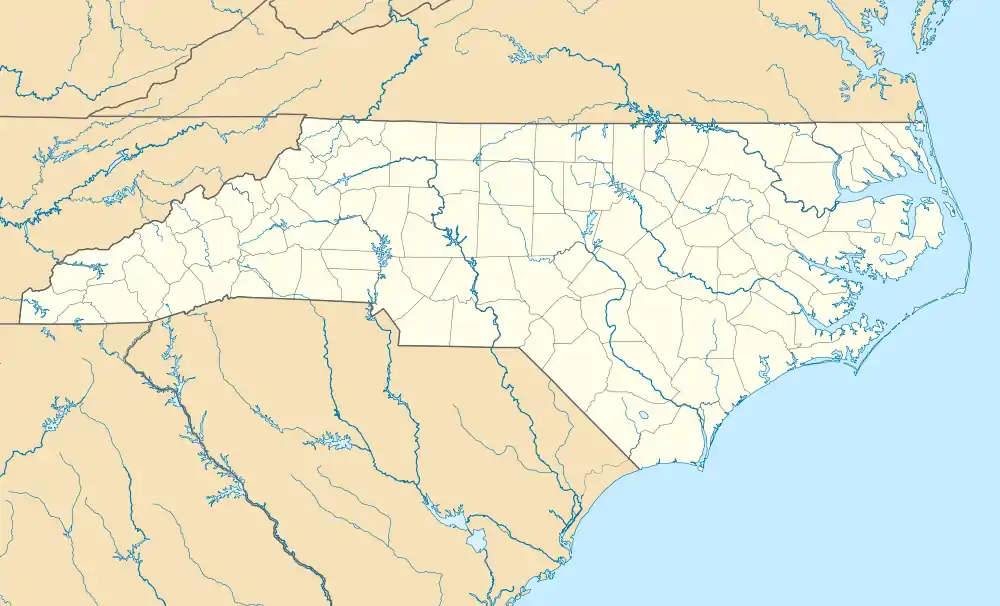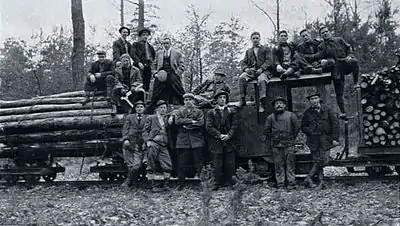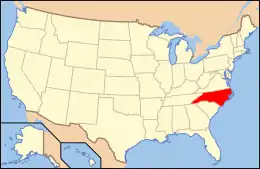Biltmore Forest School
The Biltmore Forest School was the first school of forestry in North America. The school of "practical forestry" was founded by Carl A. Schenck in 1898 on George W. Vanderbilt's Biltmore Estate near Asheville, North Carolina. The school grounds are now part of Pisgah National Forest in Transylvania County, North Carolina.
Biltmore Forest School | |
.jpg.webp) The Biltmore Forest School | |
  | |
| Nearest city | Brevard, North Carolina |
|---|---|
| Coordinates | 35°21′4″N 82°46′52″W |
| Built | September 1, 1898 |
| Architect | Multiple |
| NRHP reference No. | 74001377[1] |
| Added to NRHP | November 19, 1974 |
Today, the former school forms the basis of the Cradle of Forestry in America, a 6500-acre historic site which features exhibits about forestry and forest conservation history.[2][3] The site includes the Forest Discovery Center, an indoor forestry museum, gift shop and cafe. There are two guided trails that include several of the school's buildings, a 1914 Climax logging locomotive and a portable sawmill.[4][5] The Center offers special programs, crafts demonstrations, nature education programs and special events.
History
In 1895, Carl A. Schenck was brought by George W. Vanderbilt from Germany to Vanderbilt's Biltmore Estate in North Carolina to work managing the vast expanses of forest lands on the estate's property. Schenck replaced Gifford Pinchot as Vanderbilt's estate forester, and immediately began introducing new scientific management and practical forestry techniques. As Schenck worked throughout Vanderbilt's vast forest lands in Western North Carolina, he found himself explaining to local young men what he was working on and why it was important to maintain healthy forests. The growing interest in forestry work Schenck found among the locals caused him to look into starting his own forestry education program.
With the permission of Vanderbilt, Schenck established the Biltmore Forest School using abandoned farm buildings on the estate grounds. This was the first school of forestry in North America. According to The Biltmore Company, the school "opened its doors on September 1, 1898."[6] According to Steven Anderson, President of the Forest History Society, this was just "a few weeks" before the opening of the New York State College of Forestry at Cornell University, under the leadership of Dr. Bernhard Fernow.[7]

The Biltmore Forest School offered a one-year course of study, and the curriculum focused on providing traditional classroom lectures in silvicultural theory supplemented with extensive hands-on, practical forest management field training. Schenck's students spent most afternoons in the forest doing hands-on work and directly applying the theories they had learned in the classroom. Schenck was a demanding, but engaging professor, and his students took to him immediately, absorbing as much of the scientific forestry theories as they could.
Biltmore Forest Fair
In November 1908, Schenck hosted the Biltmore Forest Fair, designed to demonstrate the accomplishments and possibilities of scientific management and practical forestry techniques, and to celebrate the 10th anniversary of his Forestry School.[8] The three-day festival ran from November 26–29, exhibiting theories of forestry taught at the school. Attendees were given forest plantation tours with Schenck as their guide, and received detailed lessons on forestry practices, planting techniques, logging operations, seed regeneration, soil composition and more.
Schenck sent personal letters inviting close to 400 people to the fair, along with these letters of invitation, Schenck also enclosed a 55-page illustrated booklet, A Forest Fair in the Biltmore Forest,[9] which served as not only a guide to the forests at Biltmore but also a textbook of forestry and conservation practices. The guests included foresters, lumbermen, furniture manufacturers, botanists, university professors and others. The fair successfully demonstrated Schenck's forestry and conservation practices, with various newspaper editorials from the region subsequently praising him.
School's end and legacy
.jpg.webp)
Vanderbilt's forest ventures had always been unprofitable. Following several years that Schenck was unpaid but paid many employees out of his own pocket, in 1909 Schenck and Vanderbilt quarreled and Schenck was dismissed as forester of the Vanderbilt estate.[10] Although the Biltmore Forest School was financially self-sustaining, he could no longer operate it on Vanderbilt's property. Schenck continued the school through 1913, though, by traveling with his students and operating from various locations including railway cars and locations in Germany.[10]
Despite the school's short existence, it laid the foundation for American forestry education. Graduates of the Biltmore Forest School became the first generation of American professional foresters. Schenck's theories of sustainable forestry greatly influenced the field, remaining important long after his death, in 1955. Today, the school continues to be celebrated as "the cradle of forestry in America" on Vanderbilt's former lands in Pisgah National Forest, and several of the remaining buildings can be seen on trails that are part of the Cradle of Forestry in America site.
Biltmore Hall, home of the College of Natural Resources at North Carolina State University, was named in honor of the school. The forestry program located there considers itself the successor to the Biltmore School.[11]
See also
References
Notes
- "National Register Information System". National Register of Historic Places. National Park Service. March 13, 2009.
- "Cradle of Forestry". Blue Ridge National Heritage Area. Retrieved 6 December 2014.
- "Cradle of Forestry In America Historic Site". USDA Forest Service. Retrieved 6 December 2014.
- "Spotlight: The Cradle of Forestry in America, Pisgah National Forest". Recreation.gov. Archived from the original on 10 December 2014. Retrieved 6 December 2014.
- "Train History Day". Cradle of Forestry. Retrieved 28 March 2018.
- Biltmore Company, The. July 24, 1998. "Cradle of Forestry Celebrates Centennial of The Biltmore School of Forestry: America's First School of Forestry." [press release] Brevard, NC. Available: http://www.biltmore.com/media/topics/nr_archives_gardens_04.asp. Accessed February 13, 2010.
- Anderson, Steven. 1998. "Introduction". P. i in Cradle of Forestry in America: The Biltmore School of Forestry, 1898-1913, Carl Alwyn Schenck. Durham, NC: Forest History Society.
- November 26, 1908: The Biltmore Forest Fair
- A Forest Fair in the Biltmore Forest
- "America's First Forest: Carl Schenck and the Asheville Experiment". Forest History Society. 2015.
- "Biltmore Hall (Robertson Wing)". projects.ncsu.edu. Retrieved 2019-12-14.
Further reading
- Schenck, Carl Alwin. Cradle of Forestry in America: The Biltmore School of Forestry, 1898-1913. Ovid Butler, ed. Durham, NC: Forest History Society, 2011.
External links
 Media related to Biltmore Forest School at Wikimedia Commons
Media related to Biltmore Forest School at Wikimedia Commons- Cradle of Forestry in America - official site
- Inventory of the Biltmore Forest School Images, circa 1890s - 1988 in the Forest History Society Library and Archives, Durham, NC
- Biltmore Forest School Photo Collection (Forest History Society)
- Schenck Manuscript Photo Collection (Forest History Society)
- Cradle of Forestry Dedication Ceremony
- "Flowers for the Living", Biltmore School alumni reunion, May 1950

